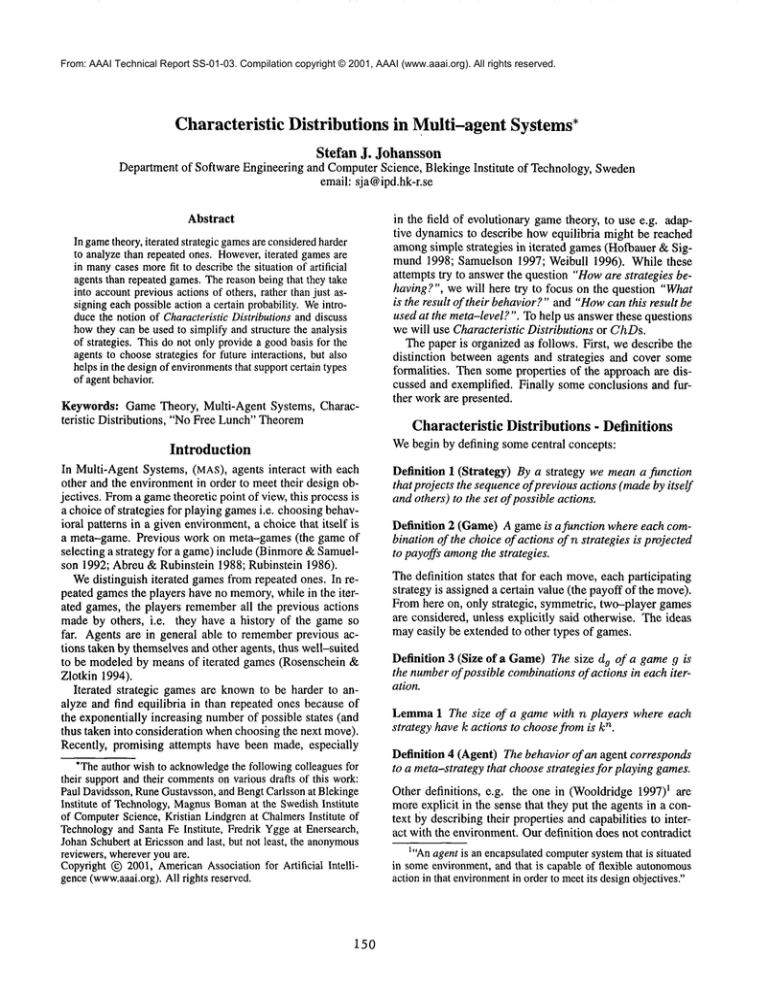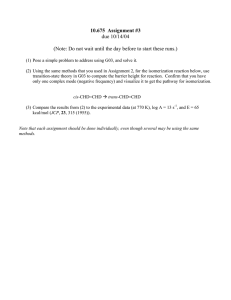
From: AAAI Technical Report SS-01-03. Compilation copyright © 2001, AAAI (www.aaai.org). All rights reserved.
Characteristic Distributions in Multi-agent Systems*
Stefan J. Johansson
Departmentof Software Engineering and ComputerScience, Blekinge Institute
email: sja@ipd.hk-r.se
Abstract
In gametheory,iterated strategic gamesare consideredharder
to analyzethan repeatedones. However,
iterated gamesare
in manycasesmorefit to describethe situation of artificial
agents than repeatedgames.Thereason beingthat they take
into accountpreviousactions of others, rather than just assigningeachpossibleaction a certain probability. Weintroducethe notion of CharacteristicDistributionsand discuss
howthey can be usedto simplify and structure the analysis
of strategies. Thisdo not onlyprovidea goodbasis for the
agentsto choosestrategies for future interactions, but also
helpsin the designof environments
that supportcertain types
of agentbehavior.
Keywords: GameTheory, Multi-Agent Systems, Characteristic Distributions, "NoFree Lunch"Theorem
Introduction
In Multi-Agent Systems, (MAS), agents interact with each
other and the environmentin order to meet their design objectives. Froma gametheoretic point of view, this processis
a choice of strategies for playing gamesi.e. choosingbehavioral patterns in a given environment,a choice that itself is
a meta-game. Previous work on meta-games (the game of
selecting a strategy for a game)include (Binmore&Samuelson 1992; Abreu& Rubinstein 1988; Rubinstein 1986).
Wedistinguish iterated gamesfrom repeated ones. In repeated gamesthe players have no memory,while in the iterated games, the players rememberall the previous actions
made by others, i.e. they have a history of the game so
far. Agents are in general able to rememberprevious actions taken by themselvesand other agents, thus well-suited
to be modeled by means of iterated games (Rosenschein
Zlotkin 1994).
Iterated strategic gamesare knownto be harder to analyze and find equilibria in than repeated ones because of
the exponentially increasing numberof possible states (and
thus taken into consideration whenchoosingthe next move).
Recently, promising attempts have been made, especially
*Theauthor wishto acknowledge
the followingcolleaguesfor
their supportand their comments
on various drafts of this work:
Paul Davidsson,RuneGustavsson,and BengtCarlssonat Blekinge
Institute of Technology,Magnus
Bomanat the SwedishInstitute
of Computer
Science, Kristian Lindgrenat ChalmersInstitute of
Technologyand Santa Fe Institute, Fredrik Yggeat Enersearch,
JohanSchubertat Ericssonand last, but not least, the anonymous
reviewers,whereveryouare.
Copyright(~) 2001,American
Associationfor Artificial Intelligence(www.aaai.org).
All rights reserved.
150
of Technology, Sweden
in the field of evolutionary gametheory, to use e.g. adaptive dynamicsto describe howequilibria might be reached
amongsimple strategies in iterated games(Hofbauer &Sigmund1998; Samuelson 1997; Weibull 1996). While these
attempts try to answer the question "Howare strategies behaving?", we will here try to focus on the question "What
is the result of their behavior?"and "Howcan this result be
used at the meta-level?". To help us answerthese questions
we will use Characteristic Distributions or ChDs.
The paper is organized as follows. First, we describe the
distinction between agents and strategies and cover some
formalities. Then someproperties of the approach are discussed and exemplified. Finally someconclusions and further workare presented.
Characteristic Distributions - Definitions
Webegin by defining somecentral concepts:
Definition 1 (Strategy) By a strategy we meana function
that projects the sequenceof previous actions (madeby itself
andothers) to the set of possible actions.
Definition 2 (Game)A gameis a function where each combination of the choice of actions of n strategies is projected
to payoffs amongthe strategies.
The definition states that for each move,each participating
strategy is assigned a certain value (the payoff of the move).
Fromhere on, only strategic, symmetric, two-player games
are considered, unless explicitly said otherwise. The ideas
mayeasily be extendedto other types of games.
Definition 3 (Size of a Game)The size dg of a game 9 is
the numberof possible combinationsof actions in each iteration.
Lemma1 The size of a game with n players where each
n.
strategy have k actions to choosefrom is k
Definition 4 (Agent) The behavior of an agent corresponds
to a meta-strategythat choosestrategies for playing games.
Other definitions, e.g. the one in (Wooldridge1997)1 are
moreexplicit in the sense that they put the agents in a context by describing their properties and capabilities to interact with the environment.Our definition does not contradict
l"Anagentis an encapsulatedcomputersystemthat is situated
in someenvironment,and that is capable of flexible autonomous
actionin that environment
in orderto meetits designobjectives."
Definition 7 (Population Distribution) The
population distribution Pa of a population P is the function
Pa :P ~ [0, 1] that tells the estimated probability of
meeting eachof the strategies in the population; especially,
let P~denote the populationdistribution of agent a.
Lemma3 Since Pa is a probability
distribution,
EtEP Pa(t) = 1, all considered strategies are in
Definition 8 (WeightedCharacteristic Distribution)
We let Chs^Dp,~ denote the weighted ChD, i.e. the sum
EtEP P~(t). ChD~.
Lemma4E~"--’I ChPp,,(i) =
^
8
Figure 1: The two-layered approach to games. At the strategy level, gamesare played according to conditions given by
the environment,whereasat the agent level the decision of
what strategy to use include modelingother agent’s choice
of strategies, a processthat is facilitated by the ChDs.
ChDp,~is in itself a ChD, since Pd can be regarded as a
mixedstrategy. Thus it sums up to I according to Lemma
3.
that, but raise the level of abstractionto strategies and games,
instead of actions in specific environments.
The payoff matrix is of the same dimensions as the ChDs
and the sameenumerationis used for the entries.
Definition 5 (Population)population (of st rategies), P
the union of all strategies that the agents in a particular
gameconsider.
Definition10 (Payoff) Let s be a strategy. Its expectedpayoff 7re (ChD~)in a gameg whenmeeting an opponentstrategyt "is definedby
There are two things worth noting here. Firstly, the agents
mayor maynot consider the same set of strategies. Secondly, we distinguish betweenthe agent level and the strategy level, wherethe strategies are purely projective, while
the agents mayhave capabilities to reason about other agents
choices of strategies, to analyze whatgameis the mostsuitable for describing the present situation in the environment,
etc. For the agent to be able to comparedifferent strategies
in order to choosean appropriate one, it mayuse ChDs(see
Fig. 1).
Definition 6 (Characteristic Distribution) The Characteristic Distribution (ChD)of a strategy s whenmeetinga strategy t in a gameof size d is defined to be the d-entry matrix
that describes the distribution of outcomes(distribution of
combinations of moves madeby the strategies). Wedenote
this C h Dby C h D~andlet C h D~( i ) be the i : th entryin this
matrix.
The enumerationof the entries is reduced to one index i,
although the ChD-matrixin the two-player case would require two index variables. This simplification is valid, as
long as the enumerationof the entries is unambiguous.Also
note that Fig. 1 has a matrix of ChDs,i.e. a matrix of matrices, since each ChD-entryin itself is a distribution of
outcomesstored in a matrix.
Lemma
2 Since all possible outcomes are considered, the
dq
sumof the entries, i.e. ~-~iZ1 ChD~(i)=
151
Definition 9 (Payoff Matrix) The payoff matrix of a game
g of size d, denoted7ro is a matrixof size d. Let 7re(i) be the
i:th entry of the matrix.
d:~
~rg(ChD~) = E ~ra(i) . ChD~(i)
(1)
i=1
Since the payoff simply is a linear function of the ChDs,
it is easy to determine what strategy is the most successful one in a certain environmentof other strategies. It is
also easy to take a subset of the entries in a ChDand
make comparisons between them. An example of such a
comparison is the one done in previous work where two of
these derivated properties, generosity and greediness, have
been studied (Carlsson, Johansson, &Boman1998). For instance, generousstrategies have shownto get higher payoffs
in noisy chicken gamesthan the greedy ones.
On optimal strategies
and games
Based on the definitions above, we will nowdiscuss some
properties that strategies and gamescan be shownto have.
Theorem2 (Existence of Nash equilibria in meta-game)
Given a population of strategies P (able of playing an arbitrary strategic gameg), the meta-gameof choosing a mix
of strategies that play g has a Nashequilibrium.
Sketch of proof: (a full proof is given in (Johansson1999)):
Weconclude that the choice of strategies given the ChD
matrix, is itself a repeated game. Repeatedgameshave Nash
equilibria, and thus, the choice of strategies for playing an
iterated gamemust have Nash equilibria. The result mean
that, regardless of what game we play, we knowthat there
is a distribution of strategies that is optimal, evenif the underlying gamefor whichwe choose the strategies, maylack
such equilibria.
Wemayalso prove the possibility of finding an optimal
gamefor a certain mix of strategies, a property that could
be useful in the design of agent environments. Imagine a
situation wherewe have an agent with a certain behavioral
pattern and we would like to design an environment that
suits that particular agent. Wecould easily, by extracting
the information about (i) the ChDsinvolving the strategy
that describe the behaviorof our agent, and (ii) the predicted
P,/, derive a payoff matrix that will favour our ownagent.
Similar lines of reasoning maybe used to custom-design
environmentsthat (in general) favour the waysin which
wouldlike the agents to behave, i.e. to create a systemof
rewards and punishmentsin order to get the agents to follow
somenormsset up by the designers of the environment.
Theorem
3 (Existence of optimal games) For all strategies
s and a populationdistribution Pc,,
1. It is alwayspossible to find a game9 in whichs is optimal.
s is a corner of the convex hull of the set of
2. If ChD
Pa
ChDs,it is alwayspossible to find a strtctly optimal game
for s.
Sketch of proof (full proof in (Johansson1999)): 1. is
ily proven, since all gamesthat give all outcomesan equal
payoff satisfy that property. 2. is shownby assigning the
combinationof outcomesthat the corner represents a higher
payoff than the other outcomes,thus rewarding s.
Theimplication of this result is that we maynot tell generally that a certain strategy will be unsuitablefor all games,
i.e. there are generally speaking no "bad strategies". Onthe
contrary, we mayalways find gamesin which every strategy, given an arbitrary, but specifically chosendistribution
of opponents, will be amongthe best.
Theorem
4 (NFL theorem for strategies) Let G be the set of
all possible games.Then, for arbitrary strategies sl and s2
and population distributions P~ and P~ :
gEG
Sketch of proof (full proof in (Johansson 1999)): Similar
to the NFLtheorem proof in (Wolpert & Macready1996).
Givenevery pair of strategies, weshowthat they are equally
good, whencomparedover all possible payoff matrices.
Froman agent perspective, this theoremimply that without any knowledgeabout the context, an agent is unable to
tell whethera certain action will be goodor bad, regardless
of whataction it is.
Conclusions
and Future Work
Wehave introduced the concept of Characteristic Distributions and explained howthey can be used to structure knowledge about howdifferent strategies behave whenthey meet.
This knowledgeis useful for agents in order to makeoptimal
choices (in a given context).
152
The ChDscombinedwith the distributions of choices of
strategies is a powerfultool for modelingan agents’ choice
of strategies. It maybe used in a variety of other settings
such as:
¯ Various types of simulations of population dynamics.
¯ Different types of situated games where the Pa is based
upon the local environment.
¯ Prevent invasions of "nasty" strategies in the population
through asserting a class of such strategies a small probability in Pd. This may(hypothetically) prevent genetic
drift toward weaker strategies, unable to defend themselves against the invaders.
¯ Use ChDsas a design tool in MASenvironment design.
Somequestions arise though, e.g. how do changes in
the level of noise or the length of the gameaffect the theories) The theory works as long as these parameters remain
the same; however,if they are changed, what the resulting
ChD’swill look like is an open question.
In all we believe that Characteristic Distributions maybe
a powerful tool for agents in deciding howto behave, a decision that has to be madebased uponthe context they are
in, accordingto the NFLtheoremfor strategies.
References
Abreu, D., and Rubinstein, A. 1988. The structure of nash
equilibrium in repeated gameswith finite automata. Econometrica 56:1259-1282.
Binmore, K., and Samuelson, L. 1992. Evolutionary stability in repeated gamesplayed by finite automata. Journal
of EconomicTheory 57:278-305.
Carlsson, B.; Johansson, S.; and Boman,M. 1998. Generous and greedy strategies. In Proceedings of Complex
Systems 98.
Hofbauer, J., and Sigmund, K. 1998. Evolutionary Games
and Population Dynamics. Cambridge: Cambridge University Press.
Johansson, S. 1999. Gametheory and agents, licentiate
thesis. Dept. of Software Engineering and ComputerScience, University of Karlskrona/Ronneby,Sweden.
Rosenschein, J. S., and Zlotkin, G. 1994. Rules of Encounter. MITPress.
Rubinstein, A. 1986. Finite automata play the repeated
prisoners dilemma. Journal of Economic Theory 39:8396.
Samuelson,L. 1997. Equilibrium Selection and Evolutionary Games. MITPress.
Weibull, J. 1996. Evolutionary GameTheory. MITPress.
Wolpert, D., and Macready, W. 1996. Nofree lunch theorems for search. Technical report, Santa Fe Institute. SFITR-95-02-010.
Wooldridge, M. 1997. Agent-based software engineering.
lEE Proceedings on Software Engineering 144:26-37.





